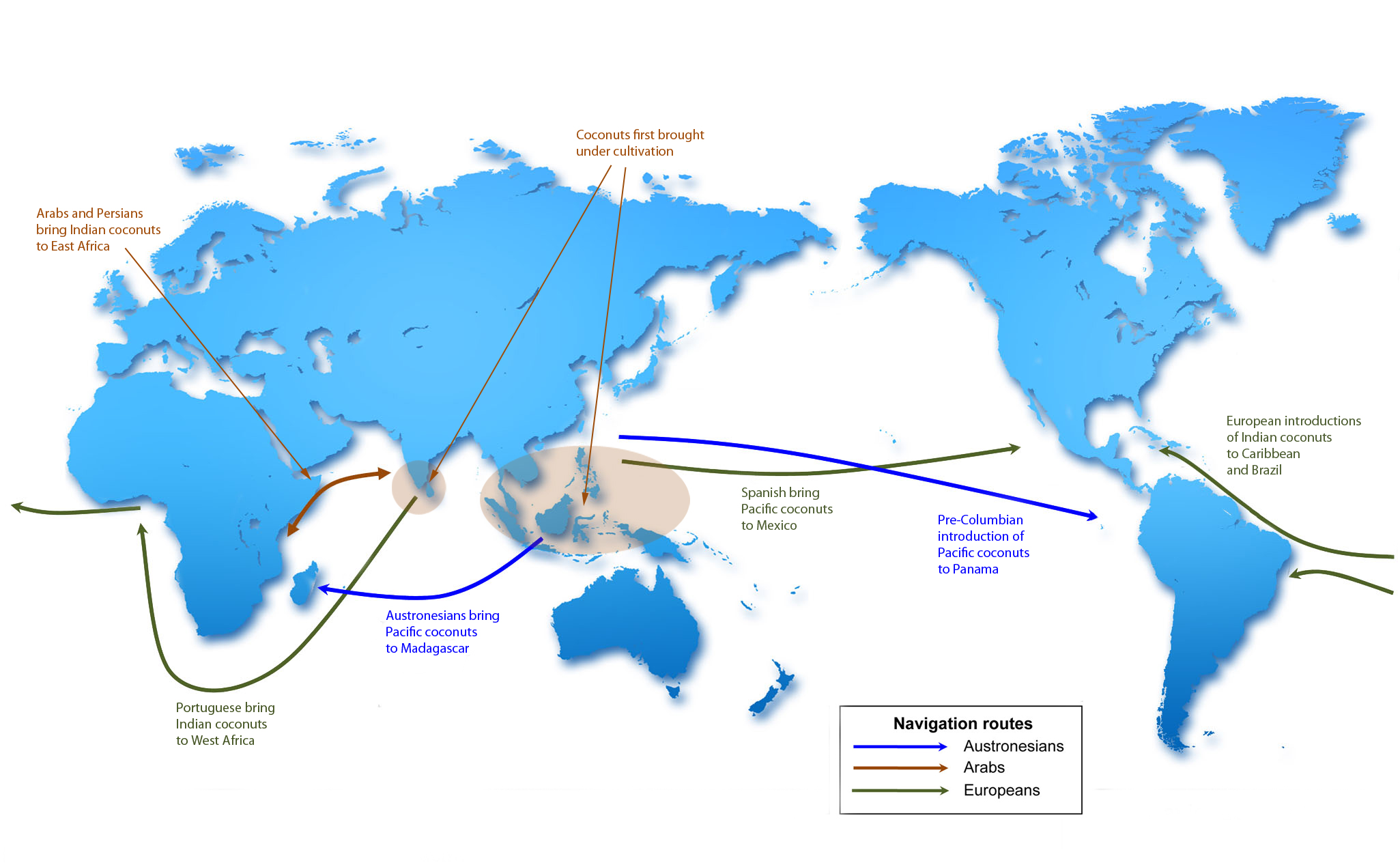
Posted on 06/24/2011 2:06:33 PM PDT by decimon
Written in coconut DNA are two origins of cultivation, several ancient trade routes, and the history of the colonization of the Americas
The coconut (the fruit of the palm Cocos nucifera) is the Swiss Army knife of the plant kingdom; in one neat package it provides a high-calorie food, potable water, fiber that can be spun into rope, and a hard shell that can be turned into charcoal. What’s more, until it is needed for some other purpose it serves as a handy flotation device.
No wonder people from ancient Austronesians to Captain Bligh pitched a few coconuts aboard before setting sail. (The mutiny of the Bounty is supposed to have been triggered by Bligh’s harsh punishment of the theft of coconuts from the ship’s store.)
So extensively is the history of the coconut interwoven with the history of people traveling that Kenneth Olsen, a plant evolutionary biologist, didn’t expect to find much geographical structure to coconut genetics when he and his colleagues set out to examine the DNA of more than 1300 coconuts from all over the world.
“I thought it would be mostly a mish-mash,” he says, thoroughly homogenized by humans schlepping coconuts with them on their travels.
He was in for a surprise. It turned out that there are two clearly differentiated populations of coconuts, a finding that strongly suggests the coconut was brought under cultivation in two separate locations, one in the Pacific basin and the other in the Indian Ocean basin. What’s more, coconut genetics also preserve a record of prehistoric trade routes and of the colonization of the Americas.
>
Far from being a mish-mash, coconut DNA preserves a record of human cultivation, voyages of exploration, trade and colonization.
(Excerpt) Read more at news.wustl.edu ...

Lovely bunch ping.
Are you implying that coconuts migrate?
>>Are you implying that coconuts migrate?<<
If I am reading the article correctly, they do. They fall off the trees, are even swept off the trees in hurricanes and the like, into the ocean where they float from place to place (the map shows the migration path).
They are very hardy.
Also, humans carry them along (which is the primary point).
It is like horses, corn and frogs.

Coconuts float, so who’s to say that they weren’t blown from trees during storms and carried by the currents to other parts of the world ?
You’re the only one that got it. Lol.
1st soldier with a keen interest in birds: You’ve got two empty halves of coconut and you’re bangin’ ‘em together.
King Arthur: So? We have ridden since the snows of winter covered this land, through the kingdom of Mercia, through...
1st soldier with a keen interest in birds: Where’d you get the coconuts?
King Arthur: We found them.
1st soldier with a keen interest in birds: Found them? In Mercia? The coconut’s tropical!
King Arthur: What do you mean?
1st soldier with a keen interest in birds: Well, this is a temperate zone
King Arthur: The swallow may fly south with the sun or the house martin or the plover may seek warmer climes in winter, yet these are not strangers to our land?
1st soldier with a keen interest in birds: Are you suggesting coconuts migrate?
King Arthur: Not at all. They could be carried.
1st soldier with a keen interest in birds: What? A swallow carrying a coconut?
King Arthur: It could grip it by the husk!
1st soldier with a keen interest in birds: It’s not a question of where he grips it! It’s a simple question of weight ratios! A five ounce bird could not carry a one pound coconut.
King Arthur: Well, it doesn’t matter. Will you go and tell your master that Arthur from the Court of Camelot is here?
1st soldier with a keen interest in birds: Listen. In order to maintain air-speed velocity, a swallow needs to beat its wings forty-three times every second, right?
King Arthur: Please!
1st soldier with a keen interest in birds: Am I right?
What terrific research. I wonder if it is possible to determine time lines from their work.
yes, interesting.
but what about breadfruit??

Yes, yes, the eternal question.
With musical accompaniment :)
For the record, these researchers are total amateurs. Not one tie in to global warming. How the heck are they ever going to get additional funding, get invited to all the cool parties or be eligible for a Nobel prize?
See Post #6. Not only did this Monty Python movie show the practical use for the coconut, they showed how they were spread: Peasants were tying them to birds. LOL
Funny movie.
Oops, didn’t read down far enough.
They are not hardy in that sense. The “eyes” of the coconut quickly soak up seawater and that kills the seed. They can float long distances by sea but they won’t arrive alive.
Not to mention it makes a handy bra in a pinch.

Back in high school days my buddies and I used to camp on Ragged Key off of Miami. We decided to extend one trip a couple of extra days and only had money for beer or food, not both.
We made the run across the bay to a marina, bought the beer and lived coconuts, beer and lobsters for a couple of days.
Disclaimer: Opinions posted on Free Republic are those of the individual posters and do not necessarily represent the opinion of Free Republic or its management. All materials posted herein are protected by copyright law and the exemption for fair use of copyrighted works.